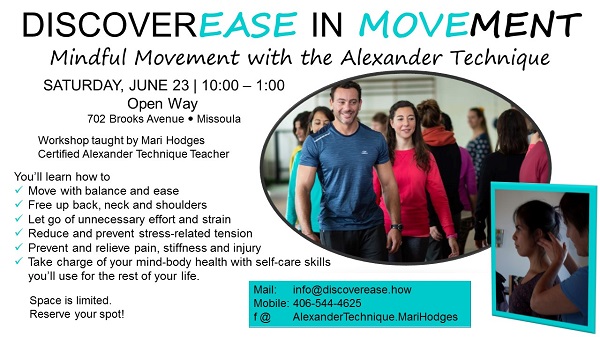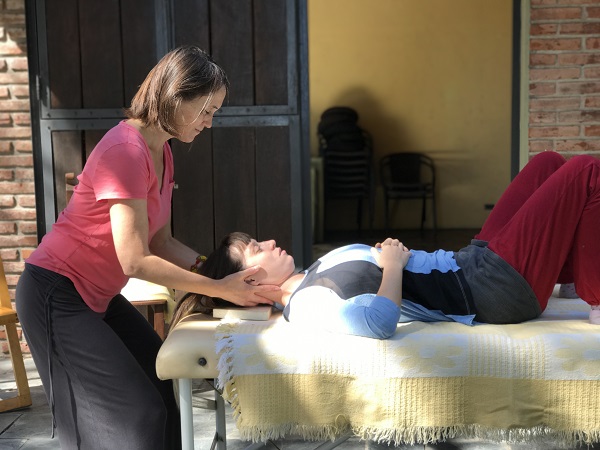Do you experience back, neck or other pain that lingers on? Or that keeps coming back? Maybe you tried going to the doctor, medication, exercise, massage, alternative therapies? All of those are great things to do and everything has it’s time and place, but I’d like to tell you about my experience with pain in the hope that it will help you.
What helped me to overcome back and neck pain that was already chronic and beginning to shoot down my arm was the Alexander Technique. For years I constantly experienced muscle spasms that left me unable to turn my head. I was used to always having some degree of pain. I was often unable to sit, stand or work comfortably, and the pain got in the way of dancing, running and enjoying life.
What I didn’t know then was that I was compressing myself and causing my pain myself. I was desperate when the insurance I had at the time wouldn’t cover any more physical therapy, massage, chiropractic, shots or drugs, and none of that was helping anyway. Some friends suggested I try Alexander Technique lessons.
In my case, the change was instantaneous. I was overjoyed to be able to move freely and I’d walk around grinning! However, it took time to be able to sustain the new way of coordinating myself without falling back into my old habits.
As I continued to learn the Alexander Technique, I learned to coordinate my mind-body self with an increased awareness of my own self and my automatic reactions. I became more and more able to see my harmful habits and to choose something different. Postural habits are an ingrained part of us, so it’s normal that we can’t see them, and they especially take control when we’re focused on doing something – which is just about all the time! But with this practice, I learned to include myself in my activities, and pay attention to the HOW rather than just focusing on the goal I wanted to accomplish.
I became more able to be in the present moment in my body and in my present surroundings. It might sound a little like meditation, and well, it is a little like that, only with your whole self and not just at specific times, but in any and every activity of life.
I decided to do the intense 1,600-hour, three-year certification program of daily half-day training. I was fascinated by Alexander’s revolutionary discovery of human head-spine coordination and wholeness of being that is supported by modern-day neuroscience and biomechanics. Always the skeptic, I questioned everything – and learned a great deal about my own habitual thought patterns. Since then, in myself and in my students I have seen repeatedly that when applied, the Alexander Technique always leads to increased mind-body coordination, which leads to reduced pain, ease of movement, reductions in stress and anxiety, improved breathing, greater spatial awareness and more.
Now I have developed the skill of paying attention to myself, my own reactions and habits as I do my activities so that they don’t get in the way of what I want to do. It doesn’t mean everything’s perfect and nothing ever hurts, but the relatively few times something does get out of whack, I know how to deal with it and I recover my equilibrium much more quickly and easily. I think that’s important to mention. We never reach a state of perfection, and that makes the process of self-discovery much more enjoyable!
The Alexander Technique is not a therapy that someone does to you, and it’s not a kind of exercise. It’s a way of relearning how to coordinate yourself naturally, that has therapeutic effects and that helps you get more out of the exercise that you do, without excess tension or strain.
Alexander’s discovery and technique for coordinating our mind-body selves is applicable to anything and everything, because it is a way of becoming aware of what we are actually doing as opposed to what we think we are doing. It’s a way of allowing our natural coordination to function rather than our self-imposed limitations.
Are you ready to learn more about yourself and get out of pain?

I’ll be teaching group and private Alexander Technique lessons in and around Mission Valley, Missoula and Helena, MT, this summer. Contact me at info@discoverease.how to schedule a private lesson or sign up for a group class. You can also bring Alexander Technique training into your workplace.
In case you’re interested, below are some studies showing the benefits of the Alexander Technique for back, neck, knee and other pain, fatigue and Parkinson’s disease.
Please feel free to forward this email to someone you think might be interested!

Learn to change habits of posture and unconscious patterns of tension to move with greater ease and freedom.
It’s possible to change these patterns to manage and reduce tension, stress and pain.
In private lessons, I use gentle contact and verbal instruction to help you rediscover your natural poise as you do movements that make up your daily life or activities.


How to learn more
To learn more, suscribe to my mailing list or read past articles. If you want to discover how you can learn to recognize and change your habitual patterns of tension, write me at info@discoverease.how to schedule a private lesson or to sign up for a group class.
You can also join the Facebook group “Mind-body freedom and balance with Alexander Technique with Mari Hodges” to read tips and ask questions.
If you have questions or a subject you’d like me to write about, please let me know! Write me at info@discoverease.how or post in the Facebook group. I’d love to hear from you!
Wishing you ease and wholeness,
Mari
Scientific research on the Alexander Technique
Here are some links to studies related to pain.
Alexander Technique and chronic back pain
Little P et al (2008). British Medical Journal 337:a884.
Patients with chronic low back pain given 24 Alexander Technique lessons had a significant reduction in pain from 21 days to 3 days per month, and an improvement in functioning and quality of life by “limiting muscle spasm, strengthening postural muscles, improving co-ordination and flexibility and decompressing the spine”.
Alexander Technique lessons or acupuncture sessions for persons with chronic neck pain: A randomized trial
MacPherson H, Tilbrook H, Richmond S, Woodman J, Ballard K, Atkin K, Bland M, Eldred J, Essex H, Hewitt C, Hopton A, Keding A, Lansdown H, Parrott S, Torgerson D, Wenham A, Watt I. Annals of Internal Medicine Nov. 2015, Vol. 163, No. 9
The Alexander Technique Lessons or Acupuncture Sessions study shows that Alexander Technique leads to a significant long-term reduction in chronic neck pain and improved self-care ability to reduce or manage pain without medication.
https://issuu.com/backcare/docs/backcare_talkback_4_2015/20
Reductions in co-contraction following neuromuscular re-education in people with knee osteoarthritis
S. Preece, R. Jones, C. Brown, T. Cacciatore and A. Jones. BMC Musculoskeletal Disorders 2016.
This study “challenges clinical management models of knee osteoarthritis which focus primarily on muscle strengthening.” Alexander Technique instruction reduced excessive muscle co-contraction and reduced the pain of patients with knee osteoarthritis by 56%.
“Taking charge, choosing a new direction: A service evaluation of Alexander Technique lessons for pain clinic patients (SEAT): An approach to pain management.“
McClean, S. and Wye, L. (2012) Project Report. University of the West of England, Bristol.
A clinical trial demonstrated the therapeutic value and effectiveness of Alexander Technique lessons for chronic back pain. Lessons were found to improve quality of life and patients’ management of pain. More than half of the patients stopped or reduced their medication, and the reduced impact that the pain had on their daily lives led to some behavioral changes and changes in awareness and self-knowledge on the part of the patients, leading to 50% reductions in pain related NHS costs.
The Impact of the Alexander Technique on Improving Posture and Surgical Ergonomics During Minimally Invasive Surgery: Pilot Study
Reddy P et al. Journal of Urology, October 2011. Volume 186, Issue 4, Supplement, Pages 1658-1662.
This study found that surgeons who underwent instruction in the Alexander Technique experienced a significant improvement in posture and surgical ergonomics as well as decreased surgical fatigue.
“Lighten Up: Specific Postural Instructions Affect Axial Rigidity and Step Initiation in Patients with Parkinson’s Disease”
Cohen, Rajal et al (2015). Neural Rehabilitation & Neural Repair, Journal of the American Society of Neurorehabilitation
People practicing instructions based on the Alexander Technique experienced a decrease in rigidity in hips, torso and neck (axial rigidity), less compression of the spine, greater postural control, and greater smoothness and ease in initiating movement.


Recent Comments